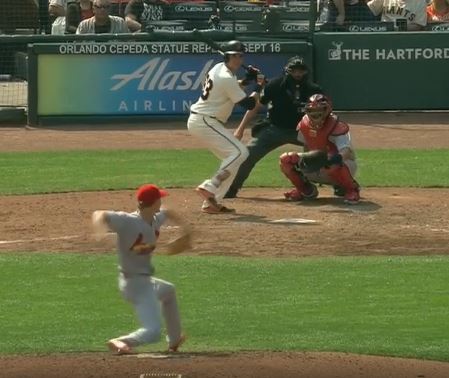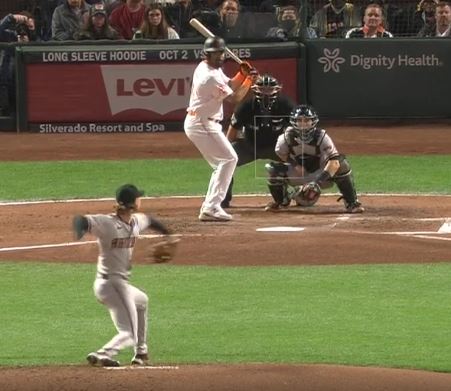Luke Weaver, Again
I have a problem. I can’t stop writing about how good Luke Weaver can be, even as he continues to be just okay. Don’t believe me? The first article I ever wrote was titled “Why is Luke Weaver so Effective?” When he started strong in the 2019 season, I was back on the same nonsense again, this time with “Luke Weaver, Retooled and Reimagined.”
As soon as I wrote that, he strained his forearm and barely pitched again that year. He came back in 2020 and 2021 and scuffled – he managed a 4.53 FIP (4.61 xFIP) in 117.2 innings, but a low strand rate as part of a brutal 2020 led to an aggregate 5.28 ERA. And here I am again, writing about how Weaver can excel in 2022.
Why do I keep doing it? Because I keep believing it! I can tell you truthfully that I think he has the tools to be a second or third starter, even though he’s been more like a fourth or fifth option so far in his career. You might wonder how that’s the case – after all, he’s basically a two-pitch pitcher, he doesn’t throw particularly hard, and his changeup, easily his best pitch, got tattooed in ‘21. I’m here to tell you: you just have to believe.
First things first: let’s look at that changeup, which carried Weaver throughout his career before abandoning him last year. If you’re just looking at the shape of the pitch, not much has changed. He’s getting a bit more fade and a bit less total downward movement (these measurements exclude gravity), but it’s still mostly the same pitch:
| Year | HMov (in) | VMov (in) | Velo |
|---|---|---|---|
| 2017 | -5.7 | 3.6 | 84.6 |
| 2018 | -7.0 | 3.6 | 85.5 |
| 2019 | -6.5 | 2.7 | 84.6 |
| 2020 | -7.8 | 4.9 | 84.6 |
| 2021 | -7.3 | 4.8 | 85.4 |
Everything else? Not great! He’s drawing fewer chases on it, and batters are making more contact even when they do chase. The problems don’t end there; when batters put his changeup in play last year, they hit for a .450 wOBA, the highest mark against the pitch in his career. Sure, it was only 68 batted balls, but it certainly didn’t look like a fluke. His xwOBA and hard-hit rate were both career highs, as was the rate of homers he allowed per batted ball.
One way to throw a similarly-shaped pitch and get it tattooed? Throw it in the wrong place. That happened here – 6.9% of Weaver’s changeups were right over the middle of the plate in 2021, the highest mark in his career. But that feels like a flimsy explanation; four fewer changeups down broadway, and he’d be doing better than his career mark before 2021. Four misplaced changeups are hardly the difference between a great pitch and a poor one, and indeed, Weaver didn’t fare poorly on those meatball-ish pitches (-0.1 run value on them). Perhaps he deserved to get shelled for them, but he didn’t.
“Did he throw it right down the middle” isn’t necessarily a great proxy for location. Weaver’s changeup benefits more from deception than movement; he’s below average in terms of both drop and fade relative to similar-velocity changeups. That means he needs to fool batters or put the ball in hard-to-hit spots, and preferably both. That means pitches away – and yeah, that hasn’t been going great on either front:
| Year | Away to RHH% | Away to LHH% |
|---|---|---|
| 2017 | 56.9% | 66.4% |
| 2018 | 40.5% | 62.0% |
| 2019 | 38.0% | 61.1% |
| 2020 | 12.6% | 55.9% |
| 2021 | 20.3% | 53.7% |
I’m at a loss to explain why this has happened, because normally I’d ascribe it to some mechanical faults that were keeping him from repeating his delivery. The only problem is, Luke Weaver always repeats his delivery. He’s a physical marvel. Don’t believe me? I took a snap of him throwing a changeup away to lefties in San Francisco four years apart. Here he is in 2017:

And again in 2021:

Both frames are the first one in the video after his lead foot strikes the ground, and he has remarkably similar back leg, throwing arm, and glove positioning in both. His athleticism has always been one of his best skills, and that’s evident in watching him throw.
I do wonder if it’s taking him a bit to adjust to a new arm angle, though. From 2017 to 2021, he’s steadily moved his release point higher and less to the third-base side. Here’s his release data for fastballs:
| Year | Vert Release (ft) | Horiz Release (ft) | Extension (ft) |
|---|---|---|---|
| 2017 | 5.42 | -1.27 | 5.95 |
| 2018 | 5.51 | -1.40 | 6.01 |
| 2019 | 5.64 | -1.05 | 5.80 |
| 2020 | 5.71 | -1.02 | 6.04 |
| 2021 | 5.76 | -0.96 | 5.95 |
Some of the change in horizontal release is just him moving on the mound, but most of it comes down to him throwing over the top more. To approximate his arm angle, I had to get a little creative, because Statcast only started using cameras to track initial spin direction in 2020, but I came up with a workaround.
Weaver’s fastball is one of those clean four-spin types. Almost all of the spin he imparts on the ball is transverse (think a tire rolling down the road), which means that the observed movement of the ball (aside from the effects of gravity) and the initial spin-imparted movement are in the same direction. Thus, we can use the angle of imparted movement as a proxy for his arm angle. As such, I worked out the angle that his fastball spun at in each year since 2017 using pitch movement data and converted it to a clock face:
| Year | Fastball Release Angle | Clock-Face Style |
|---|---|---|
| 2017 | 240.8 | 12:58 |
| 2018 | 242.2 | 12:56 |
| 2019 | 242.1 | 12:56 |
| 2020 | 247.9 | 12:44 |
| 2021 | 247.2 | 12:46 |
That’s not a huge difference, but it explains how he’s releasing the ball higher without shortening his stride. A pure over-the-top delivery is 12:00, 1:30 is exactly three-quarters, and Weaver is on a quest to throw from a higher slot. His 2019 also makes more sense when taking this data into account – his release point increased without his arm angle changing. He did this by shortening his stride slightly – his lowest stride length was in 2019. In 2020 and 2021 he lengthened his stride back out, but still threw from a higher initial release point by changing his arm angle.
Is this evidence of anything? If you want to believe, you can make it evidence that Weaver only needs to work a bit on adjusting to his new arm slot to get his changeup command back in order, which would be a huge tailwind to his game.
You might think that fixing his changeup command wouldn’t be enough, but I’d disagree. See, as I already mentioned, I’m a huge Weaver believer. His fastball, though unassuming in terms of pure velocity, misses bats surprisingly well. Not only that, but getting away from his three-quarters delivery is giving it a shape that Kevin Goldstein would love. That’s led to more empty swings for opposing hitters:
| Year | HMov (in) | VMov (in) | SwStr% | Whiff% |
|---|---|---|---|---|
| 2017 | -4.9 | 7.8 | 9.1% | 20.3% |
| 2018 | -4.8 | 8.1 | 8.7% | 19.1% |
| 2019 | -4.9 | 8.2 | 7.7% | 17.2% |
| 2020 | -4.3 | 9.6 | 8.4% | 17.3% |
| 2021 | -4.3 | 9.1 | 9.5% | 18.7% |
It’s a good thing the fastball plays, because Weaver’s cupboard is bare aside from the fastball and changeup. He threw his cutter 14% of the time in 2019, but it was down to 6% this year. I like the pitch as a complement to his changeup, because it features similar speed and drop but breaks the opposite way, to the tune of more than a foot of separation. But I agree with Weaver’s sparing use; it’s not a great pitch against lefties and doesn’t induce a ton of chases, so it’s best as a change of pace against righties, which is how he used it last year.
If you’re a Weaver completionist, you could argue he throws a curveball. He threw exactly 21 of them in 2021, and 14 of them were to opposing pitchers. “It had a positive run value!” is something you could say. “He threw it only to pitchers” is something I’d say back to you, and I’d win that argument.
I’ve written a lot of words about my enduring pitcher crush, but I think it basically boils down to this: if Weaver can combine his new fastball shape with changeup command, I’m into it. His changeup has, at times, been an excellent secondary pitch even against right-handers. Even in 2021, when the pitch got tattooed overall, he got swinging strikes on 17.5% of his right-on-right changeups. That plus the cutter against righties, and a fastball/changeup diet to lefties, should make for a solid major league starter.
A counterpoint: wishes aren’t horses. Weaver should be a solid starter if he can iron out a few things and combine the best parts of several seasons. So should lots of pitchers! The league is full of guys who, if they could harness that one nasty secondary pitch they throw and keep pumping hard-to-hit fastballs, would be solid starters.
What makes Weaver different? To me, it’s two things. First, he’s done it before. In 2017 and again in 2019, his changeups-and-moxy blend worked. Second, I like betting on athletic pitchers. Weaver’s ability to repeat his delivery is downright uncanny. He’s shown the ability to locate his pitches to get the most out of them. I want to bet on that, because it seems like a harder skill to develop than a knockout pitch.
Maybe I’ll be wrong, I don’t know. In fact, you could even say I’ll probably be wrong. Neither ZiPS nor Steamer see Weaver as anything more than a back-of-rotation starter. If he turns in another season like this one, I’ll join the chorus. Until then, I’m a Weaver Believer – and I’ll twist the data however I need to to justify my feelings.
Ben is a writer at FanGraphs. He can be found on Bluesky @benclemens.

eager beaver Weaver believer–a deceiver or a fever? The achiever fastball to the receiver, stretched like a cantilever, ain’t no Seaver.